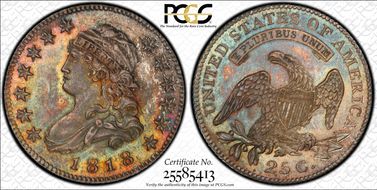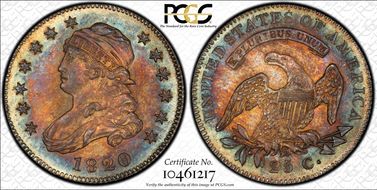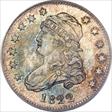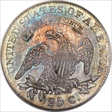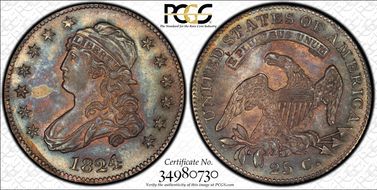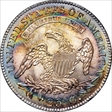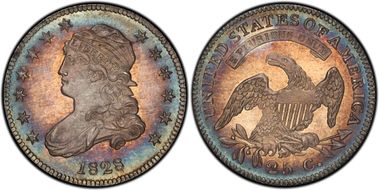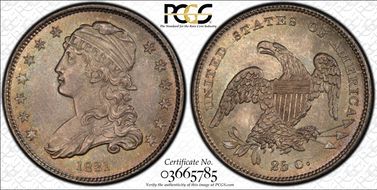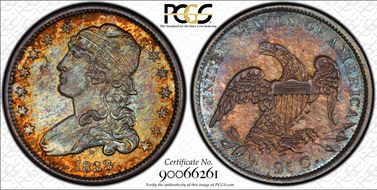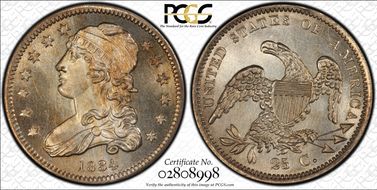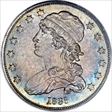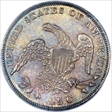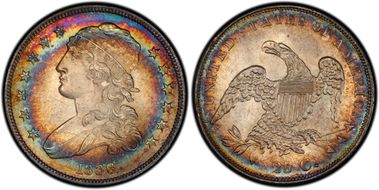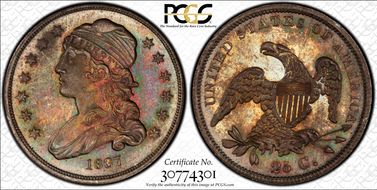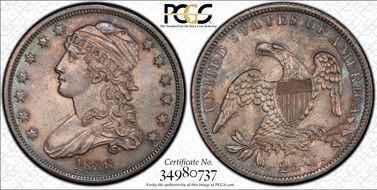The Link Early American Silver Capped Bust Quarter Date Set 的钱币相册
B-1 R.1. CAC. Tied Finest Known. "Several die states are known for the 1815 quarter, this piece being a later die state with very light clashing on each side but most notable on the reverse. Beautifully toned in shades of mauve, orange-gold, light purple and hints of green with exceptional luster and truly lovely overall eye appeal. PCGS has certified just 3 at this level with nothing graded finer and this is the only coin verified at this level by CAC. From The Clarendon Collection," per Mike Printz. "The December delivery was sent upon request of the Planter's Bank, who apparently needed the coins as a replacement for Mexican two reales coins of a similar value. An exchange of letters took place between Bailly Blanchard, cashier of the Planter's Bank, and Mint Director Robert L. Patterson. Blanchard insisted that the bank could only use quarter dollars, while Patterson wanted to send the entire amount in dimes. More than six months elapsed from the first letter requesting the coins and the date they were delivered. Several die states are known for the 1815 quarter, and this piece is a later die state with light clash marks on each side, especially visible on the reverse. It is probably one of the later January 10 coins. It is also a lovely Condition Census candidate with full silver luster beneath heavy iridescent toning, deepening to steel along the borders. Population: 3 in 66, 0 finer (11/09)," per heritage cataloger. Obtained by private treaty with Michael Printz at Harlan J Berk, Ltd. on 7/14/2013. Prior Heritage Auction 31136 on January 7, 2010, Lot 2503.
B-1 R.1. CAC. Tied Finest Known. "Several die states are known for the 1815 quarter, this piece being a later die state with very light clashing on each side but most notable on the reverse. Beautifully toned in shades of mauve, orange-gold, light purple and hints of green with exceptional luster and truly lovely overall eye appeal. PCGS has certified just 3 at this level with nothing graded finer and this is the only coin verified at this level by CAC. From The Clarendon Collection," per Mike Printz. "The December delivery was sent upon request of the Planter's Bank, who apparently needed the coins as a replacement for Mexican two reales coins of a similar value. An exchange of letters took place between Bailly Blanchard, cashier of the Planter's Bank, and Mint Director Robert L. Patterson. Blanchard insisted that the bank could only use quarter dollars, while Patterson wanted to send the entire amount in dimes. More than six months elapsed from the first letter requesting the coins and the date they were delivered. Several die states are known for the 1815 quarter, and this piece is a later die state with light clash marks on each side, especially visible on the reverse. It is probably one of the later January 10 coins. It is also a lovely Condition Census candidate with full silver luster beneath heavy iridescent toning, deepening to steel along the borders. Population: 3 in 66, 0 finer (11/09)," per heritage cataloger. Obtained by private treaty with Michael Printz at Harlan J Berk, Ltd. on 7/14/2013. Prior Heritage Auction 31136 on January 7, 2010, Lot 2503.
B-2 R1. CAC. Shield Holder. "Popular B-2 Variety, Only One Finer Coin at PCGS. No quarters were struck in 1816 and 1817, but a substantial mintage of 361,174 pieces was produced in 1818. Five obverse and seven reverse dies were combined to produce 10 known die varieties for the date. This coin represents the B-2 variety, with star 13 repunched and the scroll starting under the center of the upright of D in UNITED. The B-2 is the most available variety of the date. The present coin is a spectacular Premium Gem with iridescent shades of greenish-gold toning that fades to blue and violet. The design elements are sharply detailed and the well-preserved surfaces display vibrant mint luster under the toning. Population: 4 in 66, 1 finer ," per Heritage cataloger. Obtained from Heritage Galleries Auction #1192 on December 5, 2013, Lot 3587.
B-3 R1. Gardner. Lovely cartwheel luster and color. Displays very late die state with all obverse and reverse die cracks. Per Heritage cataloger of the Eugene Gardner, "Sole finest at NGC. Ex: Andre Dawson. Ex: Dawson. Both sides of this wondrously preserved Premium Gem are well-detailed considering the extensive die use, the strike being a smidgen soft on Liberty's highest curls, the upper-left stars, and the eagle's beak and talons. The surfaces are drenched in a warm gray and golden patina, intermingling with accents of aquamarine." The Eugene H. Gardner Collection II US Coins Heritage Signature Auction - New York #1214 on October 27, 2014, Lot 98343.
B-5 R5-. CAC. Finest Known and Discovery Coin for this Rare Die Marriage. Breathtaking color, luster and surfaces. Per Pogue Collection cataloger, "The Discovery Coin for 1820 Browning-5 Finest Known Example 1820 Capped Bust Quarter. 1820 Browning-5. Rarity-5. Small 0. Mint State-66 (PCGS). “Probably the finest known for the die marriage and by a large margin.” — W. David Perkins Pedigreed to our sale of May 1951, this miraculous gem is the discovery coin for what became known as Browning-5, a combination not known to Browning in his 1925 book, and rarely found better than Very Fine. This is the single finest known specimen, the prettiest as well, with lightly reflective surfaces swimming in marvelous satiny luster. The toning is bold enough to defy a description that will match it, with rose and gold centers barely passing through magenta on their way to concentric circles of light blue and champagne gold. The strike is somewhat soft on the drapery clasp and some of the upper tresses of Liberty’s hair, typical of this die marriage, as is the slight softness on the eagle’s head. The obverse fields are nearly immaculate, while the reverse shows a light abrasion on the eagle’s head and two minor hairline scratches elsewhere in the vicinity. The obverse die shows some spalling, or chipping of the die surface, between stars 2 and 3 and in the field next to them, also seen in the Browning-4. The reverse is clashed, an accident that befell it while married to 1821 obverse 2 (1821 Browning-4), and shows a crack through E of UNITED. This variety is an example of a remarriage, two dies that were once paired, then paired with other dies, before coming back to their original combination at a later die state. This precise specimen allowed Walter Breen to first identify this variety in 1951, at which time it was offered as part of a consignment from the “J.H. South Collection.” W. David Perkins has suggested that the J.H. South name was actually a pseudonym used for consignments coming from Wayte Raymond, who was then dispersing coins remaining from the Waldo C. Newcomer and Col. E.H.R. Green collections. Attributed incorrectly as a Browning-4 in the 1951 auction, it was further described as “an uncirculated gem. Bought as a proof. Sharp edges. Very scarce.” While the obverse of the Browning-5 is the same as that found on Browning-4, the reverse is actually that of Browning-2, which the eagle-eyed Walter Breen spotted though no one else did. Today, fewer than 30 specimens of Browning-5 have been identified in all grades, most of them lower than Very Fine. The second finest is the Pittman coin, graded About Uncirculated in the 1998 Pittman sale, though it has recently been certified as MS-62 by NGC. There are no other gem specimens. Of course, there is also but one discovery specimen. Publications: Extensively discussed in Early Quarter Dollars of the United States Mint by Rory R. Rea, Dr. Glenn Peterson, Bradley S. Karoleff, and
B-1 R2. Finest Known by 3 grading points. Only 4 large Sized Capped Quarters are graded MS67 at PCGS (and none finer) Per cataloger,"Single-Finest Certified. Recently Rediscovered Example. B-1, R.2, MS67 PCGS. A small mintage of 64,080 Capped Bust quarters was accomplished in 1822, with just two die varieties known for the date. This coin represents the more available B-1 variety, easily recognized by the Square Base 2 in the denomination. The scarce B-2 variety displays a blundered 25/5/50 denomination, and employs a Curl Base 2 numeral punch. A single obverse die was used to strike the entire production run and all coins seen were struck from perfect dies. The Capped Bust quarters were first studied and attributed by die varieties in the 1870s, by Captain John W. Haseltine and John Colvin Randall. In his famous Type Table catalog from November 1881, Haseltine described the 1822 B-1 quarter in lot 1330 as: "1822; No. 1; upper left star points to the junction of the upper curl with the band on the forehead; rev., P and I in 'Pluribus' are slightly to the left of being under the centres of S and second T in 'States' very fine; scarce." The lot realized $3.40, a strong price for the time. More recent sales include the spectacular MS64 NGC example from the "Colonel" Green-Eric P. Newman Collections (Heritage, 11/2013), lot 33168, which realized $25,850. That coin was billed as the finest known business-strike 1822 B-1 quarter at the time, but this piece easily eclipses it. The present coin has been off-the-market for decades and is not included in any recent Condition Census. It is the single-finest certified example at either of the leading grading services, with no serious challenger. We believe it is the Anderson Dupont example, last sold in lot 1796 of that Stack's sale in November of 1954, but the low-quality of the image in that appearance makes plate matching problematic. Like most examples seen, this coin shows just a touch of softness on some stars and the eagle's claw, but the eagle's feathers and Liberty's hair and drapery are boldly rendered. The impeccably preserved surfaces radiate vibrant mint luster, under spectacular shades of gold, lavender, and silver-gray toning. Eye appeal is terrific. This coin is a Registry Set essential. Population: 1 in 67, 0 finer (4/15)." Obained from Heritage Long Beach Auction #1221 on June 4, 2015, Lot 3896.
B-1 R2. Finest Known by 3 grading points. Only 4 large Sized Capped Quarters are graded MS67 at PCGS (and none finer) Per cataloger,"Single-Finest Certified. Recently Rediscovered Example. B-1, R.2, MS67 PCGS. A small mintage of 64,080 Capped Bust quarters was accomplished in 1822, with just two die varieties known for the date. This coin represents the more available B-1 variety, easily recognized by the Square Base 2 in the denomination. The scarce B-2 variety displays a blundered 25/5/50 denomination, and employs a Curl Base 2 numeral punch. A single obverse die was used to strike the entire production run and all coins seen were struck from perfect dies. The Capped Bust quarters were first studied and attributed by die varieties in the 1870s, by Captain John W. Haseltine and John Colvin Randall. In his famous Type Table catalog from November 1881, Haseltine described the 1822 B-1 quarter in lot 1330 as: "1822; No. 1; upper left star points to the junction of the upper curl with the band on the forehead; rev., P and I in 'Pluribus' are slightly to the left of being under the centres of S and second T in 'States' very fine; scarce." The lot realized $3.40, a strong price for the time. More recent sales include the spectacular MS64 NGC example from the "Colonel" Green-Eric P. Newman Collections (Heritage, 11/2013), lot 33168, which realized $25,850. That coin was billed as the finest known business-strike 1822 B-1 quarter at the time, but this piece easily eclipses it. The present coin has been off-the-market for decades and is not included in any recent Condition Census. It is the single-finest certified example at either of the leading grading services, with no serious challenger. We believe it is the Anderson Dupont example, last sold in lot 1796 of that Stack's sale in November of 1954, but the low-quality of the image in that appearance makes plate matching problematic. Like most examples seen, this coin shows just a touch of softness on some stars and the eagle's claw, but the eagle's feathers and Liberty's hair and drapery are boldly rendered. The impeccably preserved surfaces radiate vibrant mint luster, under spectacular shades of gold, lavender, and silver-gray toning. Eye appeal is terrific. This coin is a Registry Set essential. Population: 1 in 67, 0 finer (4/15)." Obained from Heritage Long Beach Auction #1221 on June 4, 2015, Lot 3896.
B-1 R5+. CAC [Gold Sticker]. Gardner. The key to the Capped Bust Quarter series. Finest Known and only uncirculated circulation strike of the 31 known specimens. Per Heritage cataloger of the Gardner Collection, "Classic unsung rarity of American Numismatics. Second in the condition census. Beautiful bluish-hazel field color complements medium gray on the device high points front and back, with amber-gold accents in some protected areas. The only mentionable contact is a tick in the lower-right obverse field, just right of the date. On the reverse, a couple of small ticks appear in the field underneath UN(ITED). The strike is somewhat blunt on the peripheral stars and the lower portion of the eagle." The Eugene H. Gardner Collection II US Coins Heritage Signature Auction - New York #1214 on October 27, 2014.
B-3 R3. Newman. Finest known. Lovely original, brightly colorful, blazing luster quarter. "MS66+ NGC. B-3, R.3. Ex: "Col." E.H.R. Green. The 1825/4 B-3 represents the second use of this overdated obverse die. This is the "1825, 5 over 4" type as listed in the Guide Book, for the many collectors who assemble sets by those major varieties. Steve M. Tompkins, in Early United States Quarters 1796-1838, suggests that the obverse die was heavily lapped between its previous use with the B-2 and its next use with the B-3: "After the lapping, the curve of the 2 disappears and the remnants of the 4 [are] much more prominent. The point of the underlying 4 digit can be seen sticking out of the left side of the upright of the 5, as well as more of the crossbar can be seen inside the loop of the 5. This has caused the B-3 die marriage to be called a 5 over 4. The remnant of either the 2 or the upright of the 4 is visible from the upper curve of the 5 to the flag of the 5 on all stages and in both die marriages, and the end of the crossbar from the 4 is visible sticking out of the right outside curve of the 5." The 1825/4 B-3 die marriage was created by using the relapped B-2 obverse die and mating it with a new reverse die. On the B-3 reverse, the scroll begins between the E and D in UNITED and ends under the right foot of the first A in AMERICA. The I in PLURIBUS is under the space between the A and T in STATES. The arrow feather is almost over the right tip of the 2 in 25C and the olive stem is over the right side of the C. This coin was stuck from the perfect state of the dies. This is the plate coin in the Rea-Peterson-Karoleff-Kovach Early Quarter Dollars of the United States Mint. This piece is also the Browning plate coin, hailing before the Green acquisition from the collection of early quarters pioneer-researcher Ard W. Browning. The Newman Collection coin, MS66+ by NGC, is the finest graded for both the die marriage and the date (10/13). This is another spectacularly toned early quarter. The obverse is attractively toned with blue on the outside surrounding lustrous gray and gold centers. The reverse is mostly a medium silver-gray, with blue and gold toning around the peripheral areas. Ex: U.S. Coin Co. (1913); Ard W. Browning; "Colonel" E.H.R. Green; Green Estate; Partnership of Eric P. Newman / B.G. Johnson d.b.a. St. Louis Stamp & Coin Co.; Eric P. Newman @ $10.00; Eric P. Newman Numismatic Education Society," per Heritage Newman catalog. Sold prior in the Heritage Eric P. Newman Auction on November 15, 2013, Lot 33346. Crossed from an NGC MS66+ holder. Private treaty with Pinnacle Rarities on March 7, 2014.
B-3 R3. Newman. Finest known. Lovely original, brightly colorful, blazing luster quarter. "MS66+ NGC. B-3, R.3. Ex: "Col." E.H.R. Green. The 1825/4 B-3 represents the second use of this overdated obverse die. This is the "1825, 5 over 4" type as listed in the Guide Book, for the many collectors who assemble sets by those major varieties. Steve M. Tompkins, in Early United States Quarters 1796-1838, suggests that the obverse die was heavily lapped between its previous use with the B-2 and its next use with the B-3: "After the lapping, the curve of the 2 disappears and the remnants of the 4 [are] much more prominent. The point of the underlying 4 digit can be seen sticking out of the left side of the upright of the 5, as well as more of the crossbar can be seen inside the loop of the 5. This has caused the B-3 die marriage to be called a 5 over 4. The remnant of either the 2 or the upright of the 4 is visible from the upper curve of the 5 to the flag of the 5 on all stages and in both die marriages, and the end of the crossbar from the 4 is visible sticking out of the right outside curve of the 5." The 1825/4 B-3 die marriage was created by using the relapped B-2 obverse die and mating it with a new reverse die. On the B-3 reverse, the scroll begins between the E and D in UNITED and ends under the right foot of the first A in AMERICA. The I in PLURIBUS is under the space between the A and T in STATES. The arrow feather is almost over the right tip of the 2 in 25C and the olive stem is over the right side of the C. This coin was stuck from the perfect state of the dies. This is the plate coin in the Rea-Peterson-Karoleff-Kovach Early Quarter Dollars of the United States Mint. This piece is also the Browning plate coin, hailing before the Green acquisition from the collection of early quarters pioneer-researcher Ard W. Browning. The Newman Collection coin, MS66+ by NGC, is the finest graded for both the die marriage and the date (10/13). This is another spectacularly toned early quarter. The obverse is attractively toned with blue on the outside surrounding lustrous gray and gold centers. The reverse is mostly a medium silver-gray, with blue and gold toning around the peripheral areas. Ex: U.S. Coin Co. (1913); Ard W. Browning; "Colonel" E.H.R. Green; Green Estate; Partnership of Eric P. Newman / B.G. Johnson d.b.a. St. Louis Stamp & Coin Co.; Eric P. Newman @ $10.00; Eric P. Newman Numismatic Education Society," per Heritage Newman catalog. Sold prior in the Heritage Eric P. Newman Auction on November 15, 2013, Lot 33346. Crossed from an NGC MS66+ holder. Private treaty with Pinnacle Rarities on March 7, 2014.
B-4 R3. CAC. Per cataloger, ""Incredible Gem 1828 Bust Quarter. Boldly Prooflike. Finest Graded by PCGS. 1828 Capped Bust Quarter. B-4. Rarity-3. MS-66+ (PCGS). CAC. The portrait of Miss Liberty is boldly rendered and displays delicate violet-gold iridescence. The surrounding reflective fields display amber and indigo iridescence radiating out toward the peripheries. The reflectivity is even more pronounced on the reverse, where the field contrasts markedly with a fully impressed, razor sharp eagle. Vibrant tangerine tones at the center of the reverse cool to teal at the borders. Virtually pristine and thoroughly appealing. This coin ranks as the single finest 1828 quarter of any die variety known to PCGS. We had the pleasure of offering this coin in our (Bowers and Ruddy) February 1976 Dr. D.C. Montgomery, Jr. Collection sale. As that time we described this piece as: ""1828 quarter dollar. Perfect reverse die. Purchased as a superb Proof, this coin possesses 99% of the characteristics of a later (i.e., Liberty seated) Proof, including prooflike surface within the shield stripes. It was undoubtedly struck as a presentation piece, so perfect are its fields and so sharp is its strike. ""If an equal or finer 1828 quarter dollar exists, we haven't seen it. Actually, it is doubtful if a finer one could exist, even in theory. A superb coin for the connoisseur!"" In the numismatic market of the 21st century, the science of positively identifying early (read: pre-1858) United States Mint Proof and specimen coins has become more exact, and PCGS has determined the present example to be a circulation strike. Proofs are known from the 1828 B-4 quarter dies, however, with the online version of the PCGS Population Report accounting for six to eight examples. That estimate squares nicely with the census of seven Proofs listed in the 2010 book Early Quarter Dollars of the United States Mint: 1796-1838 by Rory R. Rea, et al. The existence of Proofs for this variety, coupled with the exceptional strike and prooflike finish of this coin, suggest that it was one of the very first circulation strikes produced after these dies were used to strike one or more of the Proofs. However PCGS is in full concurrence with our earlier (and also current) assessment of this coin as they have confirmed it as the finest 1828 quarter ever to pass through their hands. One of the leading highlights in the Kaselitz Collection -- which is saying quite a lot given the multitude of significant offerings herein. This Gem is sure to see spirited bidding among leading numismatists. Pedigree: Ex our (Bowers and Ruddy's) Dr. D.C. Montgomery, Jr. Collection sale, February 1976, lot 1271.PCGS Population (all die varieties of the issue): just 1; 0 finer." Obtained from Stacks Bowers Auction of the Douglas Kaselitz Collection on July 17, 2015, Lot 5142.
B-1 R2. Pogue. Lovely original surfaces with tan-grey toning infused with color highlights. Strong cartwheel luster. Perhaps the best buy for quality among the superb gem Pogue quarters. Per cataloger, "Superb Gem 1831 Quarter Dollar. First Year of the Small Planchet Type. 1831 Capped Bust Quarter. Browning-1. Rarity-3. Small Letters. Mint State-66 (PCGS). “…Mr. Kneass, whose celerity in his profession could have sufficed to furnish all the dies we have necessarily employed within the last five years.” — Mint Director Samuel Moore, 1835 Intact and abundant cartwheel luster covers surfaces gracefully toned with hints of olive and gold folded into the frosty medium gray patina. A nearly flawless gem, with immaculate fields and just a single tiny mark on Liberty’s cheekbone. The strike is definitive. Two jagged die cracks encircle the reverse, the first starting under 2 of the denomination and connecting every peripheral design element on the left side of the reverse up to E of STATES, the second joining 5 of the denomination to C and the lower two arrowheads. Not a great rarity in lower Mint State grades, but this piece is among the very finest known, tied with several others as the finest seen by PCGS. This year saw a change among Capped Bust quarters, a shift to smaller planchets and a redesigned portrait by William Kneass, a well-known Philadelphia engraver. Kneass became chief engraver of the U.S. Mint in 1824 after a long career as a plate engraver. His work includes the central devices of the Small Planchet quarters, as well as the gold designs of 1834 (copied from the work of John Reich). These designs, despite their fine execution, would be relatively short-lived, replaced with designs accomplished by Christian Gobrecht, hired in mid-1835 with the title of “second engraver.” Quarter dollar production was relatively small in 1831, outpaced in raw numbers by the mintages of dimes, half dimes, cents, and half dollars, the latter denomination far outnumbering the others with nearly six million pieces coined. The modest quarter mintage of 398,000 pieces was pushed into circulation and saw plentiful commerce before the hoarding of the Panic of 1837 set in. Thus, while coins in Very Fine or Extremely Fine condition are commonplace, true gems like this are rarities. Among those as pristine as this one, few are as aesthetically impressive. This coin enjoys the first position in the Rea-Koenings-Haroutunian census. PCGS# 38980. NGC ID: 23RW. Publications: Cited in Early Quarter Dollars of the United States Mint by Rory R. Rea, Dr. Glenn Peterson, Bradley S. Karoleff, and John J. Kovach, Jr., 2010. Provenance: RARCOA’s session of Auction ’90, August 1990, lot 644; Heritage’s sale of June 2006, lot 1310; Joseph C. Thomas Collection; Heritage’s sale of April 2009, lot 2328, via Larry Hanks." Obtained from Stacks Bowers Auction of the D. Brent Pogue Collection on May 19, 2015, Lot 1079.
B-2 R.2. CAC. Eliasberg. Pogue. Perhaps the Finest Known 1832 Quarter. Per cataloger, "Splendid Gem 1832 Quarter Dollar. Considered a Proof by Breen. From the Eliasberg Collection 1832 Capped Bust Quarter. Browning-2. Rarity-2. Mint State-65 (PCGS). “B-2. Short arrows, not ending near border. (1) Eliasberg.” — Walter Breen, 1976 The D. Brent Pogue coin is a beautifully toned example that sits atop the Condition Census for this variety. Bright blue peripheries yield momentarily to magenta before reaching the highly lustrous fields. The central obverse is nearly brilliant with a tinge of gold and highly prooflike; the reverse is more golden toned and satiny in finish. Some fingerprint toning appears a bit cloudy in the left obverse field. A glass reveals some minor hairlines and evidence of handling, nothing that seriously affects the magnificent aesthetic appeal the rich toning and luster provide. A thin untoned area right of the date may appear to be a scratch but was just left untoned by a thread or something similar laying on the coin’s surface. Sharply struck on both sides. A thin die crack connects the curl to the inner points of star 13 and star 12, revealing that Browning-2 was struck before Browning-1. The obverse of this piece is so reflective that Walter Breen counted it as a Proof in his Encyclopedia of United States and Colonial Proof Coins, written in 1976 and revised in 1989. This was discussed in the 1997 Eliasberg catalog, which noted “if this is a Proof, it would qualify as one of only four such coins for this coinage date. If this coin is deemed a business strike, it may qualify as the finest known circulation strike of the variety and possibly the finest known for the date.” Today, after a good deal of study and more refined definitions of what constitutes a Proof of this era and what does not, there are no 1832 quarters that have received current recognition as Proof coins. This piece may well be the closest thing there is to a Proof of this date. Beyond that, it is recognized as the single finest known example, a magnificent specimen with one of the most important provenance chains in modern American numismatics: Louis E. Eliasberg, Sr. to the D. Brent Pogue Collection. PCGS# 38988. NGC ID: 23RX. Publications: Cited in Walter Breen’s Encyclopedia of United States and Colonial Proof Coins, 1722-1989. Cited in Early Quarter Dollars of the United States Mint by Rory R. Rea, Dr. Glenn Peterson, Bradley S. Karoleff, and John J. Kovach, Jr., 2010. Provenance: Louis E. Eliasberg, Sr. Collection, before 1976; Richard A. Eliasberg, by descent; Bowers and Merena’s sale of the Louis E. Eliasberg, Sr. Collection, April 1997, lot 1402; Alan Mandelstemm Collection; Superior Galleries’ sale of February 2006, lot 537 (as NGC MS-66)." Obtained from Stacks Bowers Auction of Brent Pogue Collection on May 19, 2015, Lot 1083.
B-1 R2. Pogue. Finest Known 1833 quarter. Blazing luster and original pristine surfaces. Per Stacks cataloger, "A die marriage of 1833 struck both before and after quarters dated 1832. This gem is a visual delight, showing some of the most magnificent toning we have seen on a coin of this design type or any of its era. Its shading and texture is most reminiscent of the toning sometimes seen on superb gems from the World War I era: dappled in gold and dark amber around the obverse periphery, blended periwinkle and violet at the center of that side, while the reverse frames the lavender center with bright pastel blue. Brisk cartwheel luster spins around both sides. The eye appeal is exceptional, and the surfaces are pristine. The strike shows some select areas of softness, particularly at some star centers and on the lowest curl, but this is not unusual for the issue. Abundant spalling, or chipping of the die surface, is present on both the obverse and reverse die. The progress of this spalling allows this coin to be placed in a striking sequence after 1833 Browning-2. Significant spalling may be seen between the date and the bust truncation, at the tip of the bust, between stars 5 and 6 into the field, above star 7, behind cap above star 8, outside the area between stars 10 and 11, and right of the date. On the reverse, the die shows spalling at E of UNITED, between STA of STATES and the beak, between the second and third arrowheads, around the denomination, and some smaller areas near the denticles. The dies have also clashed, with a faint clash visible around the central reverse and a heavy clash of the shield gules around Liberty’s ear. Just two die marriages of quarters were dated 1833, though not all quarters struck in 1833 bore that date. Through examination of the die states, students of the series have found that this die variety was made before a portion of the coins from the die marriage known as 1832 Browning-2. This marriage used a reverse die that was used twice in 1831 and once in 1832, but some of those 1832 coins were actually struck in 1833. Such studies seem confusing to the uninitiated, but fascinate specialists, who avidly follow the appearance of each microscopic die flaw that indicates a further degradation of the die surface and enables a continuum such as this to be logically constructed. The die state of this coin is among the latest known, placing its production after all the coins dated 1832 and nearly all the coins dated 1833. Adding further interest, this coin is the single finest example seen by PCGS. PCGS# 38989. NGC ID: 23RY. Provenance: Lawrence R. Stack Type Set, by sale." Obtained from Stacks Bowers Auction of Brent Pogue Collection on May 19, 2015, Lot 1085.
B-4 R.1. CAC. Pogue. Tied Finest Known. Flashy cartwheel luster over light pewter toned, fully proof like surfaces. Many fine lines on the obverse and a few on the reverse are die polishing lines, which at first glance resemble hairlines but are not. Very clean surfaces free of hairlines in fact. Per Pogue Collection cataloger, "Tied for Finest Known1834 Capped Bust Quarter. Browning-4. Rarity-1. Mint State-66 (PCGS). Lightly toned and nearly as struck. A mostly brilliant gem whose exceptionally reflective obverse and extraordinary strike give it a highly prooflike look. Faint golden toning is present on obverse and reverse, but the silvery brilliance remains bright on both sides. The strike is exceptionally bold, with many raised die finish lines visible in the fields and the raised texture and engraving strokes of the design punches visible on the devices. The obverse is immaculate, and the reverse shows just a very minor batch of hairlines near the eagle’s neck and above the wing on the right. No contact marks of any consequence are seen. While the obverse is perfect, the reverse shows a host of delicate die cracks. D of UNITED is connected to the bottoms of ST, then to a crack that joins the bases of ATES to the center of OF. A light crack descends through the left base of the first A of AMERICA from the rim to the top of the wing, and a crack at the tip of that wing crosses two arrow shafts before crossing the lowest arrowhead and continuing to the rim. A final fine crack joins the talons to the branch end, the arrow feathers, and two olive leaves before intersecting the rim. This coin, acquired privately and with no traceable earlier provenance, ranks with the finest examples from these dies in the Rea-Koenings-Haroutunian census, a listing topped with an MS-67 (NGC) coin that brought $100,000 in the Superior session of Auction ’90 and two NGC MS-66 coins, including the Haig Koshkarian coin. The only auction offering we locate of any 1834 quarter graded MS-66 by PCGS was in April 2005, though that specimen was a Browning-1. PCGS# 38995. Provenance: RARCOA, by sale." Sold at the Stacks Bowers Auction of the D. Brent Pogue Collection on May 19, 2015, Lot 107. Obtained by private treaty with Laura Sperber of Legend Numismatics and John Albaneese on May 30, 2015.
B-5 R.2. CAC. Gardner. Tied second finest at PCGS. Per cataloger, "Condition census for the date and variety. This stellar Gem B-5 1835 quarter is toned medium-gray in the centers while combining blue peripheral accents and hints of rose-gold in the fields. The surface quality is outstanding, as expected for the grade. This piece is identifiable by a pair of minute nicks in the field before Liberty's chin and another tick on the neck. The strike is sharp on all of Liberty's curls and each star save for star 7, which lacks the central radial lines." Sold previously in the Heritage Auction #1214 of the Eugene Gardner Collection on October 27, 2014, Lot 98351. Obtained by private treaty with legend Numismatics on October 31, 2014.
B-5 R.2. CAC. Gardner. Tied second finest at PCGS. Per cataloger, "Condition census for the date and variety. This stellar Gem B-5 1835 quarter is toned medium-gray in the centers while combining blue peripheral accents and hints of rose-gold in the fields. The surface quality is outstanding, as expected for the grade. This piece is identifiable by a pair of minute nicks in the field before Liberty's chin and another tick on the neck. The strike is sharp on all of Liberty's curls and each star save for star 7, which lacks the central radial lines." Sold previously in the Heritage Auction #1214 of the Eugene Gardner Collection on October 27, 2014, Lot 98351. Obtained by private treaty with legend Numismatics on October 31, 2014.
B-3 R1. Newman and Green. Finest Certified for the Variety and Year. Per Heritage cataloger, "Ex: "Col." E.H.R. Green. Early Quarter Dollars Plate Coin. Five different die marriages were used in 1836 in striking a reported 472,000 quarters. Four of those die marriages were known to pioneer Bust quarter researcher Ard W. Browning in 1925. The fifth die marriage known, 1836 B-5, was discovered by Robert Spangler in 1988. Ranked High R.6 today, it is by far the rarest variety of the year. The B-2 and B-3 marriages are the most frequently seen for the year, which saw the use of four obverse dies. The obverse of the B-3, used only in this die pairing, shows star 13 about centered between the curl and the dentils. The left edge of the lowest hair curl is over the left side of the 6. The date is punched relatively low, the lowest of any die for the year. Three reverse dies were used in 1836. This reverse die is again solely seen in the B-3 variety. The 25C is low and closer to the dentils than to the eagle; the eagle has a tongue. The arrow feather is over the right half of the 2 in 25C, and the olive stem is over the right half of the C. This Superb Gem with the added NGC Star designation was stuck from an advanced state of the dies on each side, showing a multitude of interesting die cracks designated as Die State d in Early Quarter Dollars of the United States Mint. This piece is the plate coin in that reference. It is the finest certified1836 B-3 quarter, and it is by three grade points the finest certified circulation strike for the date. Concentric multicolored rings encircle Liberty on the obverse of this beautiful, originally toned coin. The reverse is toned an even light to medium gold, with blues and deeper amber-gold at the rims. Ex: "Colonel" E.H.R. Green; Green Estate; Partnership of Eric P. Newman / B.G. Johnson d.b.a. St. Louis Stamp & Coin Co.; Eric P. Newman; Eric P. Newman Numismatic Education Society. Crossed by Jason Carter from NGC 67* to PCGS MS67. Obtained by private treaty from Jason Carter on December 4, 2014.
B-2 R1. CAC. Gardner. Exquisite beauty with color, dazzling luster and great eye appeal. private treaty with Legend Numismatics on October 22, 2014. l
B-1 R1. Tied Finest known. Lovely original surfaces with underlying luster.






















